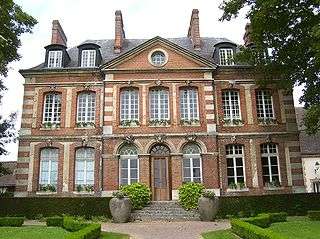Bernay, Eure
| Bernay | ||
|---|---|---|
| Subprefecture and commune | ||
|
Hôtel de la Gabelle | ||
| ||
 Bernay | ||
|
Location within Normandy region  Bernay | ||
| Coordinates: 49°05′N 0°36′E / 49.09°N 0.60°ECoordinates: 49°05′N 0°36′E / 49.09°N 0.60°E | ||
| Country | France | |
| Region | Normandy | |
| Department | Eure | |
| Arrondissement | Bernay | |
| Canton | Bernay | |
| Intercommunality | Bernay et ses environs | |
| Government | ||
| • Mayor (2008–2014) | Hervé Maurey (NC) | |
| Area1 | 24.03 km2 (9.28 sq mi) | |
| Population (2008)2 | 10,480 | |
| • Density | 440/km2 (1,100/sq mi) | |
| Time zone | CET (UTC+1) | |
| • Summer (DST) | CEST (UTC+2) | |
| INSEE/Postal code | 27056 /27300 | |
| Elevation |
87–173 m (285–568 ft) (avg. 108 m or 354 ft) | |
|
1 French Land Register data, which excludes lakes, ponds, glaciers > 1 km² (0.386 sq mi or 247 acres) and river estuaries. 2 Population without double counting: residents of multiple communes (e.g., students and military personnel) only counted once. | ||
Bernay (French: [bɛʁnɛ]) is a commune in the west of the Eure department about 50km from Évreux in northern France. The city is in the Pays d'Ouche and the Lieuvin. On its territory run the Charentonne, a tributary of the Risle, and the Cosnier.
History
The etymological origin of Bernay indicates that it is a marshy place, which comes as no surprise since it is built at the place where the River Charentonne meets an incline ("les Monts"). The Cosnier is an important tributary of the River Charentonne.
Between 996 and 1008 the duke of Normandy, Richard II offered this area in dowry to his wife, Judith of Brittany, who built a Benedictine abbey at once. The monks used the rivers flowing through the area for industry, for example cleansing, mills, fisheries. An abbey was built and it remains a jewel of the Norman Romanesque architecture. To cover the expenses and to assure their protection, the monks yielded a part of their property in 1048.
The town's cloth industry is famous, and it has many fairs (the "Foire Fleurie" at the time of Palm Sunday is memorable), because of the diversity and the abundance of the agricultural produce of the area. Bernay holds a big market each Saturday, which takes over much of the old part of the town. The veneration of "Notre-Dame de la Couture" (13th century) is the starting-point of important pilgrimages which attract people from all Normandy; the diocesan Marian pilgrimage still takes place each Whit Monday.
During the 19th century the road system was developed to modernize the city, and the evolution of industry moved towards the outskirts of the town. This development continued during last century, with the arrival of new industries and the considerable extension of Bernay on the slopes overhanging the traditional centre, which has remained faithful to its origins.
During World War II, the city escaped the Canadian bombardment in August 1944 thanks to a thick layer of cloud, thus preserving the attractive but unremarkable historical centre.
Population
| Historical population | ||
|---|---|---|
| Year | Pop. | ±% |
| 1793 | 5,705 | — |
| 1800 | 6,271 | +9.9% |
| 1806 | 6,521 | +4.0% |
| 1821 | 6,332 | −2.9% |
| 1831 | 6,605 | +4.3% |
| 1836 | 7,244 | +9.7% |
| 1841 | 6,871 | −5.1% |
| 1846 | 7,512 | +9.3% |
| 1851 | 7,362 | −2.0% |
| 1856 | 7,237 | −1.7% |
| 1861 | 7,566 | +4.5% |
| 1866 | 7,510 | −0.7% |
| 1872 | 7,281 | −3.0% |
| 1876 | 7,643 | +5.0% |
| 1881 | 7,989 | +4.5% |
| 1886 | 8,310 | +4.0% |
| 1891 | 8,016 | −3.5% |
| 1896 | 7,966 | −0.6% |
| 1901 | 8,159 | +2.4% |
| 1906 | 8,115 | −0.5% |
| 1911 | 7,883 | −2.9% |
| 1921 | 7,440 | −5.6% |
| 1926 | 7,587 | +2.0% |
| 1931 | 7,700 | +1.5% |
| 1936 | 7,783 | +1.1% |
| 1946 | 8,174 | +5.0% |
| 1954 | 8,798 | +7.6% |
| 1962 | 9,349 | +6.3% |
| 1968 | 10,009 | +7.1% |
| 1975 | 10,539 | +5.3% |
| 1982 | 10,548 | +0.1% |
| 1990 | 10,582 | +0.3% |
| 1999 | 11,022 | +4.2% |
| 2008 | 10,480 | −4.9% |
Personalities related to the town
- Romuald Boco, soccer player
- Edith Piaf, singer
- Olivier Picard, archaeologist
International relations
See also
References
| Wikisource has the text of the 1911 Encyclopædia Britannica article Bernay. |
| Wikimedia Commons has media related to Bernay (Eure). |

